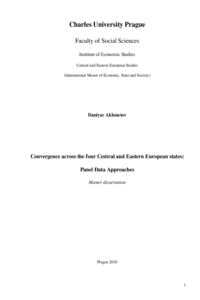Convergence across the four Central and Eastern European states: Panel Data Approaches
diplomová práce (OBHÁJENO)

Zobrazit/
Trvalý odkaz
http://hdl.handle.net/20.500.11956/24425Identifikátory
SIS: 149546
Kolekce
- Kvalifikační práce [18431]
Autor
Vedoucí práce
Oponent práce
Cahlík, Tomáš
Fakulta / součást
Fakulta sociálních věd
Obor
Středoevropská a východoevropská studia
Katedra / ústav / klinika
Katedra ruských a východoevropských studií
Datum obhajoby
23. 6. 2010
Nakladatel
Univerzita Karlova, Fakulta sociálních vědJazyk
Angličtina
Známka
Dobře
Klíčová slova (česky)
Beta-konvergence, determinanty konvergence, tranziceKlíčová slova (anglicky)
Beta-convergence, determinants of convergence, transitionThe aim of the work is to analyze the convergence in the Czech Republic for the period of 1996- 2006. The paper is based primarily on the Barro and Sala-i-Martin's theories of convergence of sub-national territorial units. The regression results proved assumptions to be realistic. The main model concentrates on a panel data approach that captures the extent to which new transport infrastructure influences within-nation regional convergence. This paper developed a regional approach to evaluate the impact of transport infrastructure, human capital and migration in four Central and Eastern European countries - the Czech Republic, Hungary, Poland and the Slovak Republic. The aim is to present an overview of the convergence process of the Czech regions between 1996 and 2006. A neoclassical growth model is used as a framework to study convergence across the 14 administrative units of the Czech Republic. Data on gross value added per capita are exploited. 1
